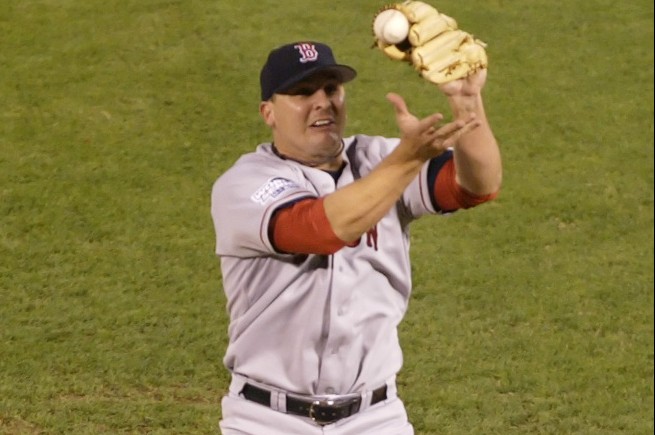Among the iconic memories in New England sports is the moment pitcher Keith Foulke underhanded the ball to first baseman Doug Mientkiewicz, clinching the 2004 World Series title for championship-starved Red Sox fans.
In the seconds after, while New England celebrated, Foulke had one thought.
“Don’t fall down,” Foulke told himself when 230-pound catcher Jason Varitek leaped into his arms.
Foulke played a key role that season, giving Boston a trusted closer it desperately needed (32 saves, 2.17 ERA). But Foulke wasn’t always a reliever, rising through the Giants’ organization as a starter.
The adjustment wasn’t simple and no one guided him in the transition.
Now Foulke, 43, wants to be that guide, hired by the Red Sox to work in developing relievers in the minors.
“In the minor leagues, the bullpen is about the only position where they don’t have coordinators and instructors,” Foulke said last week at Hadlock Field. “It’s something I’ve been talking to a few people about for the last few years. In January the Red Sox called me, we talked and here we are.
“I’m just going to work on that with these guys, so when they start moving up the ladder, they’re comfortable with it on that big stage. Hopefully they have a routine, a program mentally and physically where they can take it from Portland to the big leagues.”
Constructing a big league bullpen is a tricky, inconsistent business. The more relievers developed from within would seem to stabilize the process. Boston’s history of homegrown relievers is spotty.
That 2004 bullpen, headed by Foulke, was put together by trades and free-agent signings.
The 2007 World Series title team featured homegrown closer Jonathan Papelbon and reliever Manny Delcarmen. Both began as starters in the minors, although Papelbon was a reliever in college.
Daniel Bard looked like an All-Star reliever in the making (1.93 ERA in 2010), but he faded at the end of 2011, was allowed to make an ill-conceived move back to the rotation and was never the same, in part because of physical issues.
Recently, Junichi Tazawa (an international free agent, signed when he was 22) is the best success story, going from a Sea Dogs starter in 2009 to a key part of the 2013 World Series champion bullpen. Tazawa is still an important setup man.
Former starter Brandon Workman and starter Felix Doubront relieved in that 2013 postseason. Doubront resisted a long-term bullpen role, faltered as a starter and was traded. Workman is recovering from Tommy John surgery.
Currently the Red Sox have Tazawa, plus former homegrown starters Matt Barnes and Noe Ramirez in the pen. Barnes (3.24 ERA, but 1.92 walks/hits per inning) and Ramirez (6.00/1.77) are still figuring it out.
But it’s apparent that Boston needs to do better in developing dependability in the pen. Thursday’s game at Fenway, when Pawtucket starter William Cuevas was used for three innings of relief – in a tie game – demonstrated the thin Red Sox relief corps.
Foulke said a crucial part in turning starters to quality relievers is a routine. He discovered that in 1997 when the White Sox acquired him from the Giants.
“It was definitely an adjustment when I got to Chicago. I had been starting and they put me in the bullpen,” Foulke said. “Going from that starter’s routine where I had 20 to 30 minutes to (warm up), down to just a couple of minutes.
“It’s learning how to prepare yourself to pitch nearly every day. You don’t get many guaranteed days off. It’s the physical part of it. There’s a big mental part of it, also. You don’t have a lot of wiggle room when you get into the game.
“There are going to be certain times when you come into the game and the game is literally on the line.”
Foulke not only brings know-how to the Red Sox minor leaguers, he has credibility.
“Obviously, just his name and him being around is unbelievable,” Sea Dogs reliever Chandler Shepherd said. “I think it’s great (having a roving bullpen instructor), especially someone like Foulke, someone who has been through it and has had a great career in the big leagues.”
That career climaxed, in the minds of Red Sox fans, when he underhanded that throw to Mientkiewicz. Then Varitek was leaping into Foulke’s arms.
But doesn’t the catcher clutch the leaping pitcher?
“That was the mindset with that team. We didn’t assume anything. Nothing was preplanned,” Foulke said. “It was one of those things that happened.
“Fortunately, I caught him and we didn’t look like a couple of goofballs falling. That was my one goal. Catching him was OK. When Mientkiewicz got there, it started getting heavy and everybody was piling on. My one thought was I didn’t want to go down. I didn’t want to be at the bottom of the dog pile. Just keep your feet.”
If the Red Sox want more dog piles in late October, they need a reliable bullpen. More homegrown relievers would help.
Send questions/comments to the editors.



